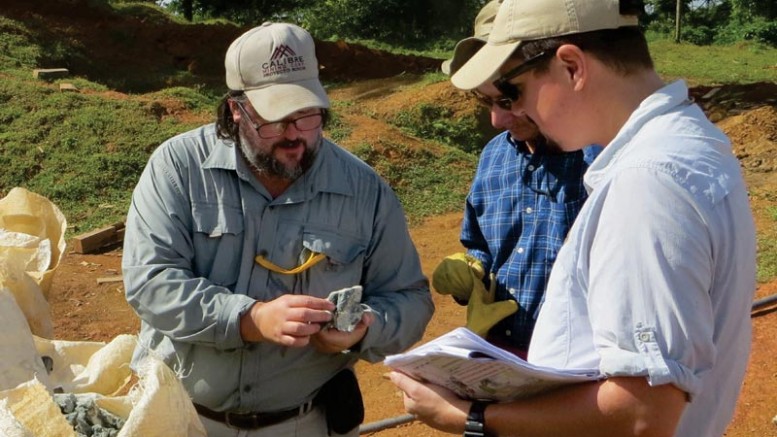VANCOUVER — Iamgold (TSX: IMG; NYSE: IAG) has given Calibre Mining (TSXV: CXB; US-OTC: CXBMF) the green light to drill the high-grade, epithermal gold-silver veins that swarm across the partners’ Eastern Borosi project, 275 km northeast of Managua, Nicaragua.
An upcoming US$1.5-million program will consist of 5,500 metres of drilling as a follow-up to 11,400 metres already completed since Iamgold entered into a joint venture with the Vancouver-based junior in May 2014.
“The first year we had tens of kilometres of structures to work through, so we did big 100-metre step-outs along them, trying to define as many high-grade shoots as we could,” Greg Smith, president, CEO and director of Calibre, tells The Northern Miner during a phone interview. “And as you know, we’ve defined a number of those, so this year we’re going back to prove up the high-grade results.”
Among the high-priority targets are the Guapinol and Vancouver veins, where drilling last year returned 1.4 metres of 98.72 grams gold per tonne and 49.1 grams silver per tonne, and 12.9 metres grading 8.73 grams gold and 11.5 grams silver.
The parallel-trending veins march in unison with a number of other underexplored gold-silver occurrences and gold-equivalent-in-soil geochemical anomalies that stretch across 10 km and counting, lending to its name, the “Guapinol–La Sorpresa” trend.
But Smith explains that the “best results to date” occur at the new Main Blag and East Dome target areas, where veins appear to jog off the Guapinol–La Sorpresa trend and balloon in size.
“We have an advantage there because the veins average 12 to 15 metres wide, so it’s easier to build up tonnes and ounces,” he says, with intercepts including 10.7 metres of 3.08 grams gold and 381.3 grams silver from Main Blag and 19.2 metres of 223.4 grams silver and 1.11 grams gold from East Dome.
The mineralized zones measure between 200 and 250 metres along strike, between 100 and 300 metres deep, and are open in all directions — with the exception of Main Blag, which is closed off to the north.
What the partners strive to achieve this year, Smith says, is to identify a “critical mass” of deposits across the 176 sq. km agreement area.
“These epithermal systems have a tried and true model. The structures go forever — or are certainly quite lensoidal — and along the longitudinal sections you get these shoots, which have ore-grade widths and grade,” he says.
The nearest example he offers is Riscos de Oro — an open-ended, parallel-trending vein 1 km northwest of Guapinol — which has a historical inferred resource of 2.2 million tonnes of 3.2 grams gold and 59.67 grams silver, for 222,300 oz. gold and 4.1 million oz. silver.
Under the deal, Iamgold can earn 51% of the project by spending US$5 million and paying US$450,000 in cash to Calibre over three years, and gain another 19% by spending US$5 million and further payments of US$450,000 over a second three-year period.
Iamgold isn’t Calibre’s only partner in Nicaragua. B2Gold (TSX: BTO; NYSE-MKT: BTG), Rosita Mining (TSXV: RST) and Centerra Gold (TSX: CG; US-OTC: CAGDF) have each taken a stake across the Calibre’s vast 934 sq. km land package, leaving half available for future negotiation.
The surge in interest even attracted gold mogul and chair of Franco-Nevada (TSX: FNV; NYSE: FNV) Pierre Lassonde, who personally poured $2 million into Calibre in 2014, earning him an 11.2% stake in the company.
“We have a great land position in Nicaragua and great partners to work with,” Smith says, noting that these partners will spend $4 million in exploration this year.
Although Nicaragua is known for its range of low- and high-sulphidation epithermal deposits — such as B2Gold’s El Limon and La Libertad operating mines, 100 km northwest and 178 km east of Managua — Smith reckons that the potential for porphyry systems in the country has been highly underestimated.
“If you look at a map of the Ring of Fire, there are porphyries dotted all the way from Alaska, B.C. and sub-western U.S., and suddenly you get to Central America, and there’s a paucity of dots,” he says. “It really doesn’t have any reason to be that way.”
Smith points to partner B2Gold’s Primavera porphyry discovery, 25 km southwest of Iamgold’s Guapinol target, where drilling unearthed 277 metres of 0.5 gram gold and 0.2% copper from surface in 2013.
B2Gold has since earned a 51% interest in 208.8 sq. km of Calibre’s concessions by spending $8 million, and plans to acquire another 19% interest by spending $6 million in project expenses over three years.
“There has to be more of these things in the district, even within a kilometre of Primavera — it’s just obvious there would be more than one of them,” he adds.
“When you think of all historic mining districts in the world — from the 1970s to early 1990s — there were so many deposits found and new models developed while dozens — if not hundreds of companies — were working within districts, but none of that happened here in Nicaragua,” he says. “It was a wasteland for 30 years … there wasn’t anybody working, and nobody developed anything during that time.
While many recall the vicious civil war that rocked Nicaragua in the 1980s, the country in the last few decades has steadily opened its doors to business and mining.
“In terms of the rules and regulations, the government is supportive — they have a modest 3% royalty on production; a 30% tax rate; no exchange control, so you can produce your gold and export it all; and a currency that’s pegged to the U.S. dollar with a fixed inflation rate per year, which means there’s no currency speculation,” he says. “There are a lot of good rules, and as a foreign company investing money in Nicaragua, you’re very much supported by the government.”


Be the first to comment on "Iamgold, Calibre set to drill in Nicaragua"